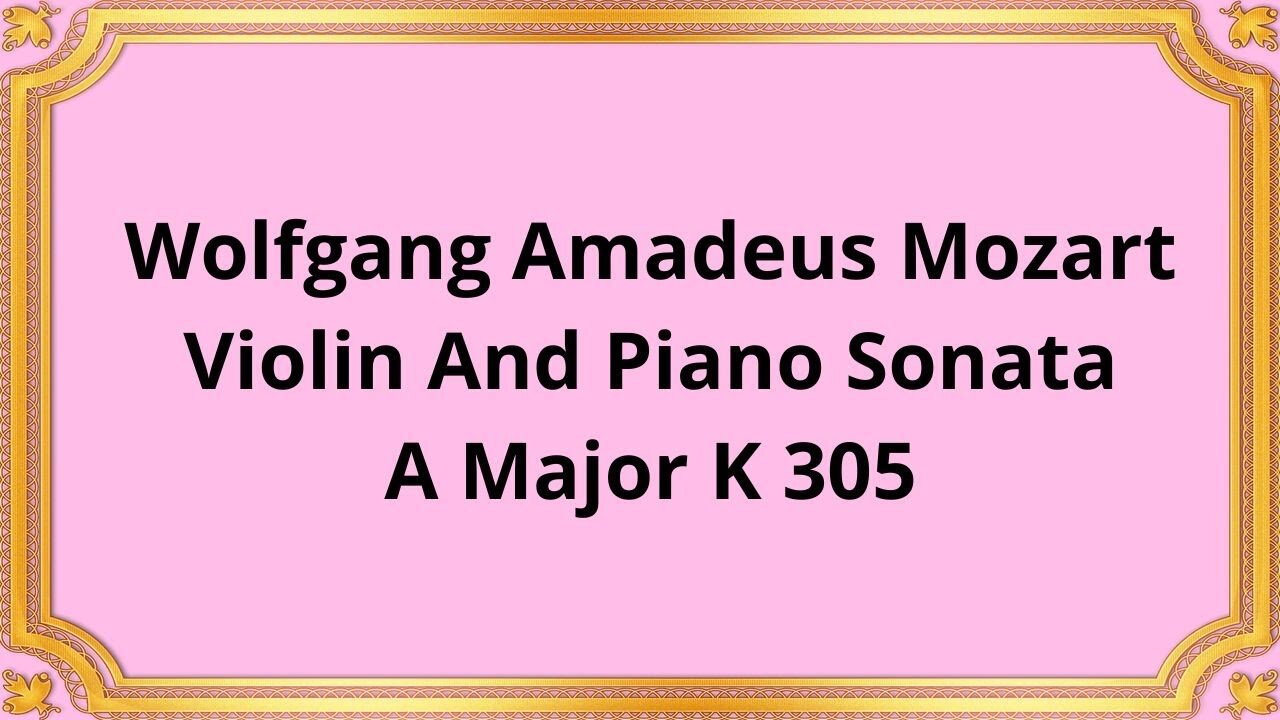Premium Only Content

Wolfgang Amadeus Mozart Violin And Piano Sonata, A Major K 305
#Mozart#Chamber_music#Classical_music#Sonata#Musical_composition
Publication date 1952
Walter Barylli; Paul Badura-Skoda
Wolfgang Amadeus Mozart's Violin and Piano Sonata in A Major, K. 305 is a masterpiece of chamber music. Composed in 1778, it is one of Mozart's most popular sonatas for violin and piano, and is renowned for its elegant melodies, technical demands, and expressive depth. In this article, we will explore the history, structure, and musical characteristics of this beloved work.
Mozart composed the Violin and Piano Sonata in A Major, K. 305 during a period of great productivity and creativity. He had recently moved to Paris, where he was trying to establish himself as a composer and musician. The sonata was likely composed as a showcase for Mozart's talents as a pianist and violinist, as well as a way to demonstrate his unique approach to chamber music.
The Violin and Piano Sonata in A Major, K. 305 is a two-movement work that follows the standard structure of the classical sonata. The first movement is in sonata form, with a lively and playful opening that sets the tone for the rest of the work. The second movement is a lyrical and expressive theme and variations, which showcases Mozart's gift for melody and his ability to develop a musical idea through subtle changes in rhythm, harmony, and texture.
One of the most striking characteristics of the Violin and Piano Sonata in A Major, K. 305 is its technical demands. Both the violin and piano parts are highly virtuosic, requiring a high level of technical skill and precision from the performers. The sonata also features Mozart's signature use of chromaticism, which adds richness and depth to the harmonic language.
Another hallmark of this sonata is its expressive depth. While the work is often characterized as light and playful, there are moments of profound emotion and beauty throughout. The second movement, in particular, is a showcase for Mozart's gift for melody and his ability to create a sense of longing and nostalgia through his music.
Conclusion
Wolfgang Amadeus Mozart's Violin and Piano Sonata in A Major, K. 305 is a masterpiece of chamber music that continues to captivate audiences today. With its technical demands, expressive depth, and elegant melodies, it remains one of Mozart's most beloved works for violin and piano.
You have the opportunity to support the channel
https://www.donationalerts.com/r/radsiaral
https://t.me/radsiar
-
 41:38
41:38
Classical music_Music Inspiration
19 days agoNikolai Andreevich Rimsky Korsakov Symphonic Suite “Scheherazade”
1381 -
 LIVE
LIVE
Glenn Greenwald
3 hours agoCongress Again Dictates Curriculum & Faculty at Private Universities; How UnitedHealth Group Silences its Critics: With NYT Reporter David Enrich | SYSTEM UPDATE #488
10,490 watching -
 LIVE
LIVE
Dr Disrespect
8 hours ago🔴LIVE - DR DISRESPECT - STREAMING UNTIL WE GET 10 WINS
1,997 watching -
 LIVE
LIVE
RiftTV
1 hour agoCON INC: We Should All Just FORGET About Epstein | The Rift | Dinesh D’Souza, Lauren Witzke + More
522 watching -
 58:21
58:21
BonginoReport
3 hours agoTrump Deepens MAGA’s Epstein Divide - Nightly Scroll w/ Hayley Caronia (Ep.91) - 07/16/2025
45.9K43 -
 LIVE
LIVE
RalliedLIVE
4 hours ago $0.68 earned10 WINS WITH THE SHOTTY BOYS
71 watching -
 LIVE
LIVE
Playback Request Live
44 minutes agoLevel Up: Our First Live Performance ft. Lady Desiree
38 watching -
 LIVE
LIVE
The Jimmy Dore Show
1 hour agoTrump Attacks His OWN Supporters As Democrat Dupes Over Epstein! Columbia University CAVES to Trump!
6,955 watching -
 1:25:13
1:25:13
Kim Iversen
2 hours agoColonel Macgregor: The Pentagon Has No Strategy, Only Targets
59.7K50 -
 12:32
12:32
JapaNomad - Video Tours
13 hours agoR35 GT-R POV Drive in Tokyo 🗼Shinjuku | Pure Car ASMR | No Music | No Voice | 4K HDR
102